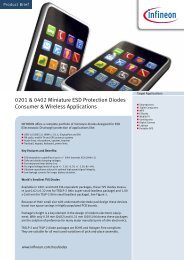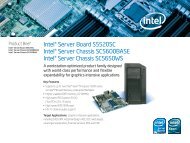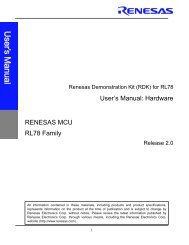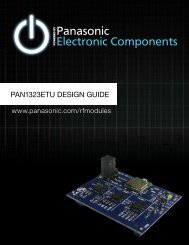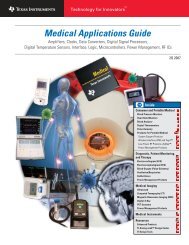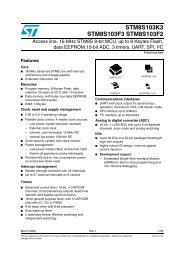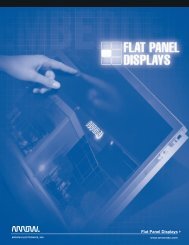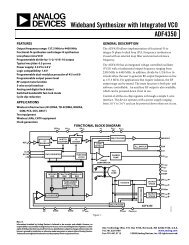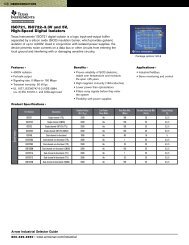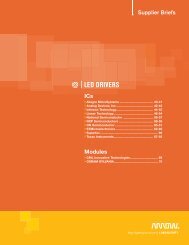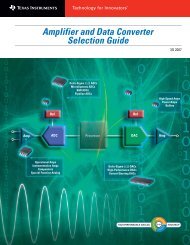Arria II GX Devices Family Overview
Arria II GX Devices Family Overview
Arria II GX Devices Family Overview
Create successful ePaper yourself
Turn your PDF publications into a flip-book with our unique Google optimized e-Paper software.
Chapter 1: <strong>Arria</strong> <strong>II</strong> <strong>GX</strong> Device <strong>Family</strong> <strong>Overview</strong> 1–3HighlightsTable 1–1. <strong>Arria</strong> <strong>II</strong> <strong>GX</strong> Device Features (Part 2 of 2)Feature EP2A<strong>GX</strong>45 EP2A<strong>GX</strong>65 EP2A<strong>GX</strong>95 EP2A<strong>GX</strong>125 EP2A<strong>GX</strong>190 EP2A<strong>GX</strong>260Transceiver TX PLLs (2) 2 or 4 (3) 2 or 4 (3) 4 or 6 (3) 4 or 6 (3) 6 or 8 (3) 6 or 8 (3)User I/O Banks (4) 6 6 8 8 12 12Notes to Table 1–1:(1) This is in four multiplier adder mode.(2) The FPGA fabric can use these phase locked-loops (PLLs) if they are not used by the transceiver.(3) The number of PLLs depends on the package. Transceiver transmitter (TX) PLL count = (number of transceiver blocks) × 2.(4) Banks 3C and 8C are dedicated configuration banks and do not have user I/O pins.Table 1–2 lists the <strong>Arria</strong> <strong>II</strong> <strong>GX</strong> device package options and user I/O pin counts,high-speed LVDS channel counts, and transceiver channel counts for ultra BGA(UBGA) and FineLine BGA (FBGA) devices.Table 1–2. Package Options and I/O Information for <strong>Arria</strong> <strong>II</strong> <strong>GX</strong> <strong>Devices</strong> (Note 1), (2), (3), (4), (5), (6), (7)Device358-Pin Flip Chip UBGA17 mm × 17 mmI/OLVDSXCVRs572-Pin Flip Chip FBGA25 mm × 25 mmI/OLVDSXCVRs780-Pin Flip Chip FBGA29 mm × 29 mmI/OLVDSXCVRs1152-Pin Flip Chip FBGA35 mm × 35 mmI/OLVDSXCVRsEP2A<strong>GX</strong>45 156EP2A<strong>GX</strong>65 15633(R D or eTX)+ 32(RX, TX,or eTX)33(R D or eTX)+ 32(RX, TX,or eTX)4 2524 252EP2A<strong>GX</strong>95 — — — 260EP2A<strong>GX</strong>125 — — — 26057(R D or eTX)+ 56(RX, TX,or eTX)57(R D or eTX)+ 56(RX, TX,or eTX)57(R D or eTX)+ 56(RX, TX,or eTX)57(R D or eTX)+ 56(RX,TX,or eTX)8 3648 3648 3728 372EP2A<strong>GX</strong>190 — — — — — — 372EP2A<strong>GX</strong>260 — — — — — — 37285(R D or eTX) +84(RX, TX, oreTX)85(R D or eTX)+84(RX,TX,eTX)85(R D or eTX)+84(RX, TX, oreTX)85(R D or eTX)+84(RX,TX, oreTX)85(R D or eTX)+84(RX, TX, oreTX)85(R D , eTX)+84(RX, TX, oreTX)8 — — —8 — — —12 45212 45212 61212 612105(R D or eTX)+ 104(RX, TX,or eTX)105(R D or eTX)+ 104(RX, TX,or eTX)145(R D or eTX)+ 144(RX, TX,or eTX)145(R D , eTX) +144(RX, TX, oreTX)Notes to Table 1–2:(1) The user I/O counts include clock pins.(2) The arrows indicate packages vertical migration capability. Vertical migration allows you to migrate to devices whose dedicated pins, configuration pins,and power pins are the same for a given package across device densities.(3) R D = True LVDS input buffers with on-chip differential termination (R D OCT) support.(4) RX = True LVDS input buffers without R D OCT support.(5) TX = True LVDS output buffers.(6) eTX = Emulated-LVDS output buffers, either LVDS_E_3R or LVDS_E_1R.(7) The LVDS channel count does not include dedicated clock input pins and PLL clock output pins.12121616© July 2010 Altera Corporation <strong>Arria</strong> <strong>II</strong> <strong>GX</strong> Device Handbook, Volume 1



